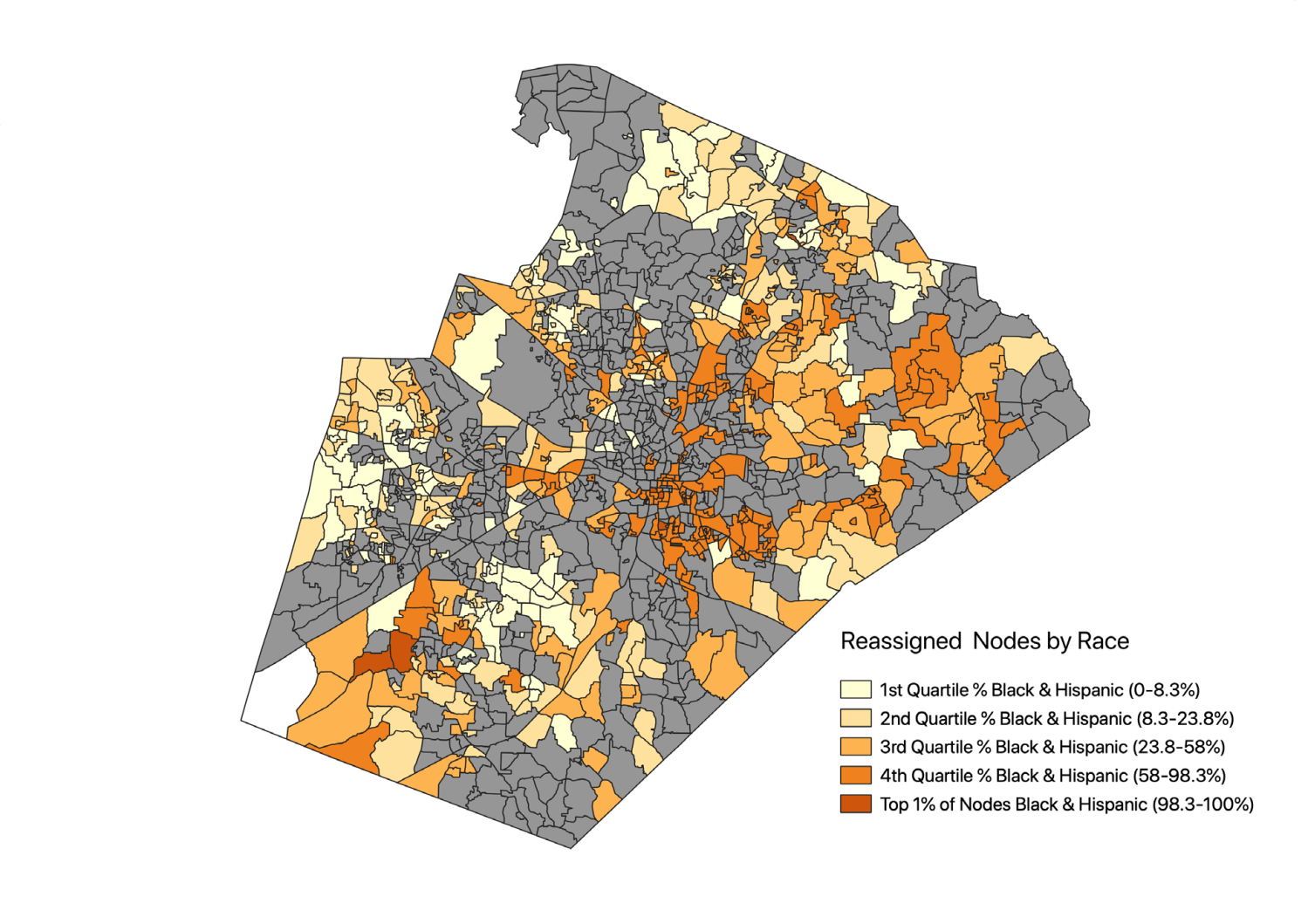School desegregation works. A growing body of evidence demonstrates that federal efforts to enforce Brown v. Board of Education and dismantle separate and unequal systems of public education improved Black children’s life trajectories—driving gains in educational achievement and attainment, increasing employment, and reducing arrests and crime victimization. This body of research finds little evidence of offsetting effects for white children.
Nonetheless, school desegregation efforts have consistently faced intense political resistance. Images of this resistance are seared in the nation’s memory: crowds of angry white protestors spitting and jeering at the Little Rock Nine as they integrated Central High School; U.S. marshals escorting nine-year-old Ruby Bridges into her New Orleans elementary school; battles between desegregation advocates and their opponents in the streets of 1970s Boston.
We might like to think that opposition to desegregation efforts is a relic of the past. This backlash, however, continues to the present day, as illustrated by recent dispatches from San Francisco, New York City, Maryland’s Montgomery County, and North Carolina’s Charlotte-Mecklenburg County. Opponents frequently argue that school reassignments for diversity purposes—often referred to as “mandatory busing”—exact academic, social, and emotional costs from reassigned students.
As districts around the U.S. grapple with high levels of racial and socioeconomic segregation, and the Biden administration prepares to make a $100 million bet on a new generation of school desegregation efforts, we wanted to know whether historical and contemporary concerns were justified.
To find out, we took a close look at North Carolina’s Wake County Public School System (WCPSS) and the socioeconomic school desegregation plan the district implemented between 2000 and 2010.
WCPSS set a goal that no school’s enrollment would exceed 40% socioeconomically disadvantaged students or 25% below grade-level students. It sought to accomplish this with a “controlled choice” approach that gave parents opportunities to choose their children’s schools but allowed the district to manage the assignment process in ways that served its desegregation goals. It divided the district into geographic nodes containing roughly 150 students each and assigned each node to a “base” elementary, middle, and high school. While families had a menu of school choices, their node’s “base” school was their default school of attendance. To maintain socioeconomic and achievement balance, WCPSS annually reassigned several nodes—and the students residing in them—to different base schools, generally reassigning relatively high-poverty residential nodes to lower-poverty base schools and vice versa.
More than 20% of students enrolled in WCPSS experienced one or more reassignments under the policy during the decade in which it was in place. In Figure 1, we map WCPSS’s residential nodes, shading reassigned nodes according to their concentration of students of color. As the map illustrates, reassignments affected students across the district, including Black, white, and Hispanic students.
Figure 1: Percent of students in WCPSS residential nodes identified for reassignment between 2000-2010 who are Black or Hispanic

Our analyses, which have just been published in the Journal of Policy Analysis and Management, yield three main conclusions.
First, although WCPSS’s policy allowed families to opt out of their newly reassigned schools, most reassigned students attended their reassigned schools. This finding is important because it suggests that districts can create more diverse and inclusive school assignment boundaries even with policies that allow a considerable degree of school choice.
Second, despite widespread concerns about the potential harms of “busing” to achieve diversity goals, we find no evidence of negative consequences of reassignment for reassigned students. Indeed, as the findings reported in Figure 2 illustrate, our analyses indicate that reassignment had modest positive effects on reassigned students’ math achievement, in the range of 0.02-0.04 standard deviations.
Figure 2: Effects of reassignment on reassigned students’ mathematics and reading achievement, suspension, and chronic absenteeism

We further find that reassigned students’ rates of suspension drop by about 1 percentage point in the year of reassignment and the subsequent year, a decline of 20% off the base suspension rate. These findings indicate that, in this case at least, concerns about the academic and social costs of school reassignment are unfounded. Carefully designed and implemented school assignment policies like the one WCPSS implemented in the early 2000s can improve school diversity without imposing academic or disciplinary costs on reassigned students. Additional analyses indicate that the benefits associated with reassignment were relatively widespread and we found no evidence to suggest that academic outcomes declined white students or students initially enrolled in low-poverty schools after reassignment.
Third, we find that students who do and do not attend their base school have similar outcome trajectories post-reassignment. We are reluctant to draw firm causal conclusions based on this finding. Nonetheless, it suggests that students benefit from reassignment whether they attend their new base schools or transfer to a choice school.
Looking Ahead—In Wake County and Beyond
As trends toward socioeconomic segregation across public schools intensify across the U.S., and the COVID-19 pandemic sheds light on deep and persistent inequalities in our public schools, we believe now is the time for educational policymakers to undertake brave and ambitious new approaches to school desegregation. WCPSS’s 2000-2010 socioeconomic reassignment policy should be a touchstone in this policy conversation. This policy–which has attracted considerable academic attention over the years–was neither perfect nor uncontroversial. In fact, voter backlash to the policy led to the election of an anti-desegregation slate of school board candidates in 2010.
Today, as the district confronts rising levels of racial and socioeconomic school segregation, it is contemplating new approaches to use school assignments to boost diversity. We believe the story of Wake County’s socioeconomic reassignments should embolden equity-oriented policymakers in Wake County and across America. By building on the WCPSS model, policymakers can realize the profound benefits of educational diversity, even in an era when courts subject racially sensitive desegregation efforts to sharp scrutiny and school-choice plans provide new opportunities for students to avoid socioeconomically diverse schools. And—contrary to widespread worries about the costs of desegregation—our analysis suggests that educational policymakers can realize these benefits while simultaneously enriching the educational experiences of reassigned students.











Commentary
Student reassignments achieve diversity without academic adversity
September 1, 2021